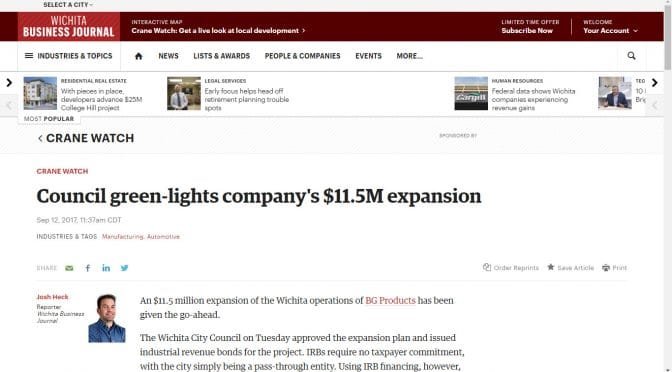The city has finalized a proposal for a development near Naftzger Park. It includes a few new and creative provisions.
This week the City of Wichita will consider a development agreement for land and buildings near Naftzger Park in downtown Wichita. 1
Community Improvement District
The plan includes the formation of a Community Improvement District. In CIDs, merchants charge additional sales tax for the benefit of the property owners, instead of the general public.2 In this CID, the proposed additional sales tax is two cents per dollar, the maximum available under state law, and could generate up to $3.1 million over a period as long as 22 years.3
This proposed CID contains a “sweetener,” likely designed to reduce public opposition. Ten percent of the CID revenue would be used to maintain Naftzger Park. We’ve seen this before, as in the Cabela’s CID where some of the funds paid for road improvements near the store.4
The action the city council will consider this week is whether to accept the petitions to form the CID and set January 9, 2018 as the date for the public hearing.
Industrial Revenue Bonds and tax forgiveness
This project is also requesting Industrial Revenue Bonds. under this program, the city will not be lending money, nor will it be responsible for repaying any loans. Instead, the program allows the developers to avoid paying sales tax on construction.5 City documents don’t give an amount of tax savings, but it could be over one million dollars. 6
City documents state that a property tax abatement is not being requested. That isn’t available for this project, as its property taxes are already allocated by TIF.
Tax Increment Financing (TIF)
The project has already been approved for of Tax Increment Financing. In this case, future property tax revenues from this project will be rerouted from their normal flow to reconstruct Naftzger Park, something that is seen as a large benefit to the developers.
Construction administration fee
The city will pay the developers up to $250,000 for construction administration of the park.
Parking
This agreement also contains something I’m sure is considered as creative. We also saw this as an incentive offered to Cargill earlier this year. In this case, the city will pay the developers a fee for using their parking spaces. In this case, the city proposes paying a one-time easement fee of $10,000 per spot for from 80 to 90 parking spots. The total payment would be from $800,000 to $900,000. These parking spots would be available to the public outside of business hours, which are defined as 6:00 a.m. to 6:00 p.m. Monday through Friday.
Private events
Buried with the development agreement is a provision that the developers may use the park for private events: “The City and the Board will cooperate with Developers, upon Developers’ request, to create an Annual Master Calendar of private and public events for the Park, with the expectation that the Developers will have the use of the Park for certain private events.”
Little else is mentioned regarding these private events, such as the maximum number of private events. This seems subject to abuse.
Other Naftzger Park material
- The city’s page for Naftzger Park
- Naftzger Park Facebook group
- Photo album on Flickr
- Chase Billingham: Who does Naftzger Park belong to?
- Naftzger Park public hearing to be considered. The Wichita City Council may set August 15, 2017 as the date for a public hearing on the future of Naftzger Park in downtown Wichita.
- Naftzger Park tax increment financing (TIF). Background on tax increment financing (TIF) as applied to Naftzger Park in downtown Wichita.
- Downtown Wichita gathering spaces that don’t destroy a park. Wichita doesn’t need to ruin a park for economic development, as there are other areas that would work and need development.
- Naftzger Park concerts and parties? In Wichita, a space for outdoor concerts may be created across the street from where amplified concerts are banned.
- Wichita Eagle: Should city shoo homeless from downtown Wichita park?
- Naftzger Park contract: Who is in control? The City of Wichita says it retains final approval on the redesign of Naftzger Park, but a contract says otherwise.
- Upcoming Naftzger Park legislative action. The redesign of Naftzger Park in downtown Wichita is not a done deal, at least not legally.
- Naftzger Park construction manager. The City of Wichita seeks a construction manager for the construction of Naftzger Park.
- Downtown Wichita business trends. There has been much investment in Downtown Wichita, both public and private. What has been the trend in business activity during this time?
- Wichita Eagle: Four designs unveiled for Naftzger Park downtown—
Notes
- City of Wichita Agenda Packet for December 19, 2017, Item IV-6. Available at http://wichitaks.granicus.com/AgendaViewer.php?view_id=2&clip_id=3699. ↩
- Weeks, Bob. Community improvement districts in Kansas. Available at https://wichitaliberty.org/kansas-government/community-improvement-districts-kansas/. ↩
- Council Agenda: “The Developer and Park Board control the land within the proposed CID. The requested CID would provide pay-as-you-go financing for qualified project costs through the imposition of a 2% special retail sales tax on all taxable retail sales within the district for a maximum of 22 years. The eligible project costs identified in the CID petition include costs of renovating the building at 691 E. William and construction of the Class A commercial building. The City will receive 10% of the CID revenue to fund Naftzger Park maintenance and or ROW repairs and improvements, in addition to the 5% administrative fee. The revenue is estimated to be $310,000. The maximum amount of project costs that can be reimbursed is $3,118,504 based on the projected revenue of the project, exclusive of the City’s administrative fee and Naftzger Park maintenance.” ↩
- Weeks, Bob. Cabela’s CID should not be approved in Wichita. Available at https://wichitaliberty.org/wichita-government/cabelas-cid-should-not-be-approved-in-wichita/. ↩
- Weeks, Bob. Industrial revenue bonds in Kansas. Available at https://wichitaliberty.org/kansas-government/industrial-revenue-bonds-kansas/. ↩
- “The Developer is also requesting the issuance of a letter of intent to issue Industrial Revenue Bonds (IRBs), valid through December 31, 2022, in an amount not-to-exceed $26,000,000 to achieve a sales tax exemption on items purchased for the redevelopment project. No property tax abatement is being requested.” ↩




 Many will undoubtedly cheer the Spirit announcement as an economic development win on a large scale. It will add many jobs. But the Wichita-area economy is so far behind it will take much more growth than this to catch up with the rest of the nation. In fact, the Wichita-area economy shrank last year.
Many will undoubtedly cheer the Spirit announcement as an economic development win on a large scale. It will add many jobs. But the Wichita-area economy is so far behind it will take much more growth than this to catch up with the rest of the nation. In fact, the Wichita-area economy shrank last year. 







